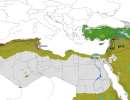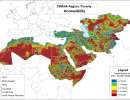GIS Data
Maps in: North Africa and West Asia
Biomass response to precipitation variability 1982-2000
This map shows the coefficient of variation of the maximum NDVI for the period 1982-2000, which is an indicator of the fluctuations in agricultural or natural biomass, which do not result from land use change and are related to current climatic variability.
The colors in orange and red express where the variability is the highest. As the CV of the maximum NDVI expresses the response of the vegetation biomass to climatic fluctuations, it is an impact indicator and hence evidence of the presence of ‘hot’ or ‘cool’ spots in different parts of CWANA.
The map shows several current hot spots:
- North Africa, from Morocco into Tunisia
- The Sahel, from Mauritania into Sudan, Eritrea, northern Ethiopia and turning south into Somalia
- The Fertile Crescent, from northern Syria, Kurdistan, turning southeast into Kuzistan and southern Iran
- The foothill zone north of the Tien-Shan and Pamir Central Asia mountain ranges
- The rangelands in the north of Central Asia
All these areas are characterized by severe droughts, degradation of land, water and vegetation resources, and sometimes famines.
Metadataclose[x]
Biomass response to precipitation variability 1982-2000
This map shows the coefficient of variation of the maximum NDVI for the period 1982-2000, which is an indicator of the fluctuations in agricultural or natural biomass, which do not result from land use change and are related to current climatic variability.
The colors in orange and red express where the variability is the highest. As the CV of the maximum NDVI expresses the response of the vegetation biomass to climatic fluctuations, it is an impact indicator and hence evidence of the presence of ‘hot’ or ‘cool’ spots in different parts of CWANA.
The map shows several current hot spots:
- North Africa, from Morocco into Tunisia
- The Sahel, from Mauritania into Sudan, Eritrea, northern Ethiopia and turning south into Somalia
- The Fertile Crescent, from northern Syria, Kurdistan, turning southeast into Kuzistan and southern Iran
- The foothill zone north of the Tien-Shan and Pamir Central Asia mountain ranges
- The rangelands in the north of Central Asia
All these areas are characterized by severe droughts, degradation of land, water and vegetation resources, and sometimes famines.
Benchmark areas, action and satellite sites of the West Asia-North Africa target region
The map shows a Benchmark Area in West Asia representing SRT2-conditions, and one in North Africa typical for SRT3-conditions. The West Asia Benchmark Area contains two Action Sites. SRT2-AS1 contains the area where research is conducted on the Rangeland-livestock based system in Jordan and Syria.
SRT2-AS2 contains the area where research is conducted on the low-potential rainfed mixed crop-livestock based system.
The North Africa Benchmark Area contains one Action Site (SRT3-AS1 in Morocco) where research is conducted on sustainable intensification of the rainfed systems in North Africa. Outside the benchmark area North Africa contains two Satellite Sites, SRT2-SS1 in Tunisia, which addresses the mountainous agro-systems, rangelands and medium potential ecosystems especially those with indigenous water harvest techniques, and SRT3-SS1 in the new and old irrigated areas of the Nile Delta, which focuses research on water and land management technologies to increase productivity.
West Asia contains an integrated SRT2-SRT3 Action Site, located in the Karkhe River Basin in SW Iran, where research is conducted using a transect approach covering highland (SRT2) and lowland (SRT3) areas.
Metadataclose[x]
Benchmark areas, action and satellite sites of the West Asia-North Africa target region
The map shows a Benchmark Area in West Asia representing SRT2-conditions, and one in North Africa typical for SRT3-conditions. The West Asia Benchmark Area contains two Action Sites. SRT2-AS1 contains the area where research is conducted on the Rangeland-livestock based system in Jordan and Syria.
SRT2-AS2 contains the area where research is conducted on the low-potential rainfed mixed crop-livestock based system.
The North Africa Benchmark Area contains one Action Site (SRT3-AS1 in Morocco) where research is conducted on sustainable intensification of the rainfed systems in North Africa. Outside the benchmark area North Africa contains two Satellite Sites, SRT2-SS1 in Tunisia, which addresses the mountainous agro-systems, rangelands and medium potential ecosystems especially those with indigenous water harvest techniques, and SRT3-SS1 in the new and old irrigated areas of the Nile Delta, which focuses research on water and land management technologies to increase productivity.
West Asia contains an integrated SRT2-SRT3 Action Site, located in the Karkhe River Basin in SW Iran, where research is conducted using a transect approach covering highland (SRT2) and lowland (SRT3) areas.
Agricultural Resource Capital and Population Density
A high-potential agricultural resource base can be insufficient for a large rural population, whereas areas with lower potential for agriculture but also lower population densities can be sustainable. This map links agricultural resource poverty to population density.
Metadataclose[x]
Agricultural Resource Capital and Population Density
A high-potential agricultural resource base can be insufficient for a large rural population, whereas areas with lower potential for agriculture but also lower population densities can be sustainable. This map links agricultural resource poverty to population density.
Accessibility to markets
This map shows travel time to cities with at least 50,000 inhabitants as an indicator of accessibility to markets.
Metadataclose[x]
Accessibility to markets
This map shows travel time to cities with at least 50,000 inhabitants as an indicator of accessibility to markets.
Absolute change in annual trend precipitation 1901-2007
This map is based on the Full Data Reanalysis Product Version 4 of the Global Precipitation Climatology Centre (GPCC). It has been obtained by linear regression fitted to the 107-year time series of annual precipitation of each 0.5x0.5 degree grid cell by the least-squares method and subsequent resampling to 0.008333 degree (about 1 km) spatial resolution. The map shows the average absolute change in mm/year as measured along the trend line between 1901 and 2007. With some exceptions (e.g. parts of the Black Sea coast and the rim of Central Asia mountains) the trend is negative in most of the region.
Metadataclose[x]
Absolute change in annual trend precipitation 1901-2007
This map is based on the Full Data Reanalysis Product Version 4 of the Global Precipitation Climatology Centre (GPCC). It has been obtained by linear regression fitted to the 107-year time series of annual precipitation of each 0.5x0.5 degree grid cell by the least-squares method and subsequent resampling to 0.008333 degree (about 1 km) spatial resolution. The map shows the average absolute change in mm/year as measured along the trend line between 1901 and 2007. With some exceptions (e.g. parts of the Black Sea coast and the rim of Central Asia mountains) the trend is negative in most of the region.







